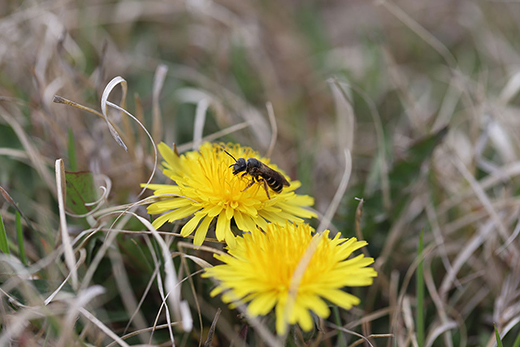K-State entomologist to lead $1M effort to expand bee project
Thursday, Sept. 5, 2024

Thanks to a new NSF grant, researchers at three universities are advancing K-State entomologist Brian Spiesman's BeeMachine project, which tracks trends in bee populations worldwide. | Download this photo.
MANHATTAN — The National Science Foundation has awarded more than $1 million to researchers at three U.S. universities to further advance a Kansas State University project that hopes to conserve one of nature's most important pollinators.
K-State entomologist Brian Spiesman launched the website BeeMachine.ai and a mobile app in 2020 to help track trends in bee populations across the world.
Spiesman said a recent update substantially improves users' ability to contribute to the citizen science effort and communicate their sightings. The update was funded by a K-State Game-changing Research Initiation Program for exploratory research, or GRIPex, award for nearly $250,000. The NSF grant will allow the researchers to continue that work.
"We are now able to identify 354 types of bees from around the world, and this number will continue to grow as we develop our image data set with the NSF project to include more types of bees," Spiesman said.
There are an estimated 4,000 bee species in North America alone and more than 20,000 worldwide. According to Spiesman, BeeMachine.ai currently contains tens of thousands of images of bees submitted from mobile app and website users.
Bees are considered one of the world's most vital pollinators. The Food and Agriculture Organization of the United Nations reports that nearly three-quarters of the world's food crops depend, at least in part, on pollination. The organization also reports that pollination has the potential to increase agricultural yields and quality worldwide.
Among the hundreds of foods that rely on pollination during development are apples, bananas, blueberries, strawberries, peaches, potatoes, vanilla, almonds, chocolate, coffee, canola, tomatoes, grapes, avocados and many more.
Spiesman added that animals also pollinate close to 90% of the world's flowering plant species.
"It is important to remember that there are more than 20,000 kinds of bees, and many of them are facing declines because of the interacting effects of habitat loss, climate change, overuse of pesticides, and invasive or noninvasive species," Spiesman said. "This great diversity of bees is one of the reasons it is so important to be able to identify the different species so we can establish which are in decline and develop effective conservation strategies."
Since the launch of BeeMachine.ai four years ago, 4,000 users have contributed more than 14,000 sightings from all continents except Antarctica. However, to fully unleash the power of artificial intelligence technology, more images and information are needed.
Spiesman said the NSF awarded K-State $372,442 to continue the work and add improvements.
"You improve artificial intelligence algorithms by adding more images, but image availability is the main limiting factor in developing reliable algorithms," Spiesman said.
K-State has formed partnerships with the University of Kansas and the University of Wisconsin — who also received money from NSF — to photograph collections of pinned bees for improving AI algorithms. Spiesman said KU has more than 500,000 bee specimens that can be added to BeeMachine; Wisconsin has several thousand, as well.
"K-State will use NSF funds to support personnel who can conduct imaging, which will allow us to continue existing partnerships with other groups, such as USDA's Agricultural Research Service in Logan, Utah, which holds more than one million bee specimens," Spiesman said.
He added that the collections from the KU and Wisconsin are curated specimens.
"We know what species they are and just need to image them for training our models," Spiesman said. "We hope to be able to add most of the 4,000 bee species in North America plus many other species in other parts of the world to our algorithm, and all of the more than 425 bee genera in the world."
Currently, Spiesman said conservationists don't have a full understanding of the extent to which bees and other critical insects are in decline, and why.
"We first need to understand the problem before we can take effective action," he said. "This project will be important for empowering people with the ability to help us gather the kind of data we need to enact effective conservation."
